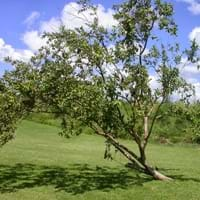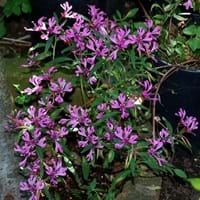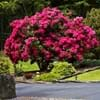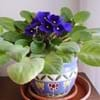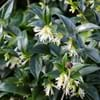Life Span
Perennial
Annual
Type
Broadleaf Evergreen
Flowering Plants
Origin
Central America, South America
United States, California
Types
Psidium guajava,Acca sellowiana
Santa Clara red ribbons, red ribbons, Raiche's red ribbons
Habitat
Moist Soils, Riverbanks, Semi arid regions
Dry areas, foothill woods
USDA Hardiness Zone
10-15
Not Available
AHS Heat Zone
Not Available
9 - 1
Sunset Zone
21,22
A3, 1a, 1b, 2a, 2b, 3a, 3b, 4, 5, 6, 7, 8, 9, 10, 11, 12, 13, 14, 15, 16, 17, 18, 19, 20, 21, 22, 23, 24
Habit
Oval or Rounded
Clump-Forming
Flower Color
White
Pink, Fuchsia, Rose, Lavender
Flower Color Modifier
Bicolor
Bicolor
Fruit Color
Yellow, Pink
Not Available
Leaf Color in Spring
Olive, Dark Green, Copper
Green, Gray Green
Leaf Color in Summer
Olive, Dark Green
Green, Gray Green
Leaf Color in Fall
Olive, Dark Green
Green, Gray Green
Leaf Color in Winter
Olive, Dark Green
Light Green
Leaf Shape
Oblong elliptic
Ovate
Plant Season
Spring, Summer, Fall, Winter
Spring, Summer
Sunlight
Partial Sun
Partial Sun, Partial shade
Type of Soil
Loam
Loam, Sand
The pH of Soil
Acidic, Neutral, Alkaline
Neutral
Soil Drainage
Well drained
Well drained
Bloom Time
Late Spring, Early Summer
Spring, Late Spring, Early Summer, Summer
Tolerances
Drought
Not Available
Where to Plant?
Ground
Container, Ground, Pot
How to Plant?
Grafting
Seedlings, Stem Planting
Plant Maintenance
Medium
Medium
Watering Requirements
Average Water Needs, Does not require lot of watering
Allow to dry out slightly between watering
In Summer
Moderate
Lots of watering
In Spring
Less Watering
Moderate
In Winter
Less Watering
Average Water
Soil pH
Acidic, Neutral, Alkaline
Neutral
Soil Type
Loam
Loam, Sand
Soil Drainage Capacity
Well drained
Well drained
Sun Exposure
Partial Sun
Part sun, Partial shade
Pruning
Prune in early spring, Remove dead branches, Remove dead leaves
Remove damaged leaves, Remove dead branches, Remove dead leaves
Fertilizers
Fertilize every three months, fertilize in growing season
All-Purpose Liquid Fertilizer
Pests and Diseases
Anthracnose, Bacteria wilt, Canker, Cercospora leaf spot, Red blotch, Ring spot
Red blotch
Plant Tolerance
Cold climate, Heat Tolerance, Variety of soil types
Drought
Flower Petal Number
Single
Single
Showy Foliage
Yes
Not Available
Foliage Texture
Medium
Fine
Foliage Sheen
Matte
Matte
Attracts
Ants, Birds, Bugs
Butterflies
Allergy
Cold, drowsiness, Mouth itching
Not Available
Aesthetic Uses
Not Used For Aesthetic Purpose
Showy Purposes
Beauty Benefits
Acne, Improve skin tone, Treatment of Dark Spots
Not Available
Environmental Uses
Food for birds, Food for insects, Shadow Tree, soil stabilisation
Air purification
Medicinal Uses
Diabetes, Diarrhea, Inflammation, Minerals
Not Available
Part of Plant Used
Bark, Fruits, Stem
Not Available
Other Uses
Application in Handicrafts, Beneficial species for attracting pollinators, Used as a nemiticide, Used as an insecticide, Used as firewood
Used as Ornamental plant, Used for its medicinal properties
Used As Indoor Plant
Yes
No
Used As Outdoor Plant
Yes
Yes
Garden Design
Container, Edible, Fruit, Fruit Tree, Hedges, Houseplant, Screening, Wind Break
Bedding Plant, Showy Tree
Botanical Name
PSIDIUM guajava
CLARKIA concinna
Common Name
Guava Tree
Red Ribbons
In Hindi
अमरूद [amarood]
Clarkia concinna
In German
Echte Guave or Goiaba or Guava or Guayaba or Guayave
Clarkia concinna
In French
Goyave or Goyavier
Clarkia concinna
In Spanish
Guayaba manzana or Guayabo
concinna clarkia
In Greek
γκουάβα [nkouáva]
Clarkia concinna
In Portuguese
goiaba
Clarkia concinna
In Polish
guawa
klarkia concinna
In Latin
Psidium guajava
Clarkia concinna
Phylum
Magnoliophyta
Tracheophyta
Class
Magnoliopsida
Magnoliopsida
Family
Myrtaceae
Onagraceae
Genus
Psidium guajava
Clarkia
Clade
Dicotyledonous
Angiosperms, Eudicots, Rosids
Tribe
Not Available
Not Available
Subfamily
Rosoideae
Not Available
Number of Species
Not Available
Importance of Guava and Clarkia concinna
Want to have the most appropriate plant for your garden? You might want to know the importance of Guava and Clarkia concinna. Basically, these two plants vary in many aspects. Compare Guava and Clarkia concinna as they differ in many characteristics such as their life, care, benefits, facts, etc. Every gardener must at least have the slightest clue about the plants he wants to plant in his garden. Compare their benefits, which differ in many ways like facts and uses. The medicinal use of Guava is Diabetes, Diarrhea, Inflammation and Minerals whereas of Clarkia concinna is Not Available. Guava has beauty benefits as follows: Acne, Improve skin tone and Treatment of Dark Spots while Clarkia concinna has beauty benefits as follows: Acne, Improve skin tone and Treatment of Dark Spots.
Compare Facts of Guava vs Clarkia concinna
How to choose the best garden plant for your garden depending upon its facts? Here garden plant comparison will help you to solve this query. Compare the facts of Guava vs Clarkia concinna and know which one to choose. As garden plants have benefits and other uses, allergy is also a major drawback of plants for some people. Allergic reactions of Guava are Cold, drowsiness and Mouth itching whereas of Clarkia concinna have Not Available respectively. Having a fruit bearing plant in your garden can be a plus point of your garden. Guava has showy fruits and Clarkia concinna has no showy fruits. Also Guava is not flowering and Clarkia concinna is not flowering . You can compare Guava and Clarkia concinna facts and facts of other plants too.
